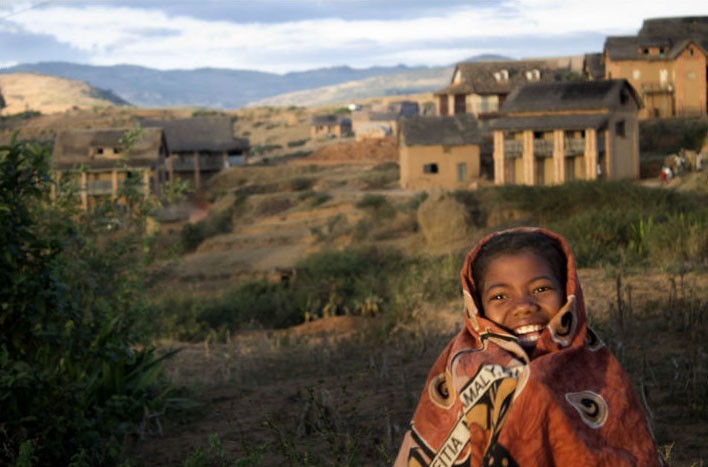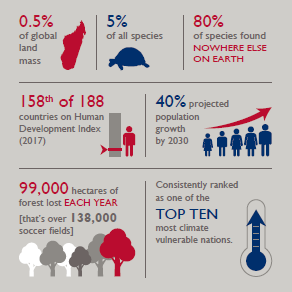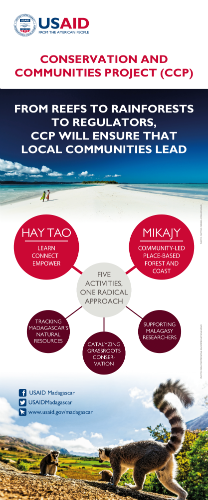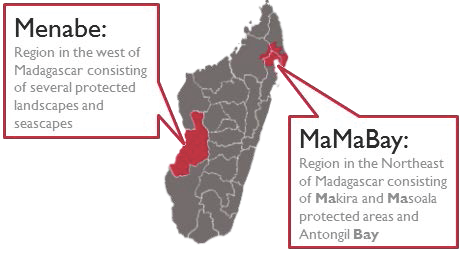Speeches Shim

Overview

Madagascar is one of the world’s highest priority countries for biodiversity conservation due to its exceptional species richness, high number of unique plant and animal species; and the magnitude of threats facing these ecologically, culturally, and economically valuable resources. There are more unique species of plants and animals living in Madagascar than on the entire African continent and more than eighty percent of its species can be found nowhere else on Earth. Because of this exceptional uniqueness of species, the loss of one hectare of forest in this country can have a larger effect on global biodiversity than forest loss anywhere else on Earth, making Madagascar arguably the highest biodiversity priority on the planet.
Challenges
Widespread and abject poverty, exacerbated by high birthrates and unsustainable land management practices, is the ultimate driver of the array of threats facing Madagascar’s rich biodiversity. Extreme poverty inhibits human growth opportunities and severely limits economic development. Rapid population growth is increasing demand for land and natural resources while environmental degradation, largely stemming from slash-and-burn agriculture, fuelwood collection, and unsustainable harvesting of wildlife, is destroying biodiversity resources and rendering many areas less productive for other uses. Illicit logging, illegal fishing practices, and unsustainable harvesting of threatened plants and animals for unlawful trade further intensify the grinding poverty facing the country and jeopardize the relevance and effectiveness of Madagascar’s government institutions. Without effective governance to protect natural resources from misuse, local populations increasingly disregard environmentally sound livelihood practices that have lasting long-term benefits, in order to meet immediate basic survival needs and prevent outsiders from appropriating their natural resources with impunity. As a result increasing numbers of Malagasy are trapped in poverty and are at high risk for becoming still poorer as natural resource stocks are permanently depleted.
In addition to these concerns, predicted climate change impacts also threaten the wellbeing of both the country’s biodiversity and its people. Given its geographic location, Madagascar is regularly subject to powerful cyclones that damage ecosystems and infrastructure, particularly on the coasts, and climate change is predicted to increase both their number and severity. In addition, rainfall patterns in some areas of the country will intensify leading to increased flooding and erosion, while rainfall in the south will lessen and become more unpredictable. The prolonged drought in the south has already caused extensive hardship for people living there and the long-term toll on the region’s biological resources has yet to be fully assessed. Increased carbon dioxide levels in the atmosphere are leading to rising sea temperatures and ocean acidity levels, which threaten coral ecosystems and other marine habitats of high economic and ecological value. Finally, sea level rise around Madagascar, which has the longest coastline of any country in Africa, will subject communities and habitats to increased damage from cyclonic and flooding events and may force many people permanently from their homes.
The Conservation and Communities Project (CCP)
Informed by over 25 years of experience in Madagascar and influenced by the Nature, Wealth, and Power 2.0 paradigm, the Conservation and Communities Project (CCP) of USAID Madagascar was developed to address these challenges.

The CCP supports the protection of Madagascar’s natural capital, a fundamental component of the country’s sustainable development, through improved conservation of the country’s unique biodiversity (Nature), promotion of resilient livelihoods to provide alternatives to unsustainable natural resource management practices (Wealth), and concrete actions to secure effective local management and ownership of natural resources (Power).
CCP Flagship Activities
USAID Hay Tao
Hay Tao /haɪ taʊ/, meaning “know how” in Malagasy, is the first of our two primary activities under the CCP. Hay Tao is being implemented by PACT in partnership with World Resources Institute and the Coastal Resources Center of the University of Rhode Island.
Hay Tao will demonstrate what happens when openings are provided to let local communities lead. Serving as a clearinghouse of best practices, Hay Tao will build out tools and knowledge resources in support of decentralized, community-driven natural resource conservation. See the Hay Tao Factsheet here.
USAID Mikajy
Mikajy /mi ka ʤi/, which means “taking good care of” in Malagasy, is a site-based conservation effort that works to reduce threats to targeted protected areas and High Biodiversity Value (HBV) ecosystems through improved management, increased economic opportunities, better access to social services, and support for natural resource tenure and property rights.
CCP Supporting Activities
PEER

The CCP supports Madagascar-based research to introduce and test innovative approaches to reducing threats to biodiversity through Partnerships for Enhanced Engagement in Research (PEER). This partnership between USAID and the United States National Academies of Sciences competitively provides grants to Malagasy researchers and research institutions who collaborate with US-Government funded researchers in the United States to build the capability of Malagasy researchers to increasingly lead research efforts to benefit the people and biodiversity of Madagascar.
Peace Corps Interagency Agreement

Through a new partnership with the Peace Corps, the CCP catalyzes grass-roots conservation by providing Peace Corps Volunteers serving in Madagascar and their communities with training and grant funding they need to implement small-scale, community-based projects. With this support volunteers are able to introduce biodiversity-friendly development alternatives and sustainable practices for community-managed landscapes and seascapes. Not only does this collaboration provide technical assistance directly at field level, it also offers CCP and our development partners a source of learning about community engagement approaches that can be shared broadly to building learning platforms in the country.
US Forest Service Interagency Agreement

The CCP is providing assistance to communities and partners that track and quantify Madagascar’s natural resources through our partnership with the United States Forest Service (USFS). Through this activity, the USFS is providing technical support to Madagascar’s “Reducing Emissions from Deforestation and Forest Degradation” (REDD+) efforts by assisting with their “Mangrove Forest Inventory” and “Carbon Quantification” projects. These measurements are important factors in the conservation decision-making and forest management processes. The mangrove forests play an important role in mitigating the impact of major storms and are an important habitat for the local animal species. They also provide resources for economic activities in these areas. Through our partnership with USFS we are also helping coastal communities to better measure carbon stocks in mangroves and thereby increase their capacity to manage important natural resources.



Comment
Make a general inquiry or suggest an improvement.